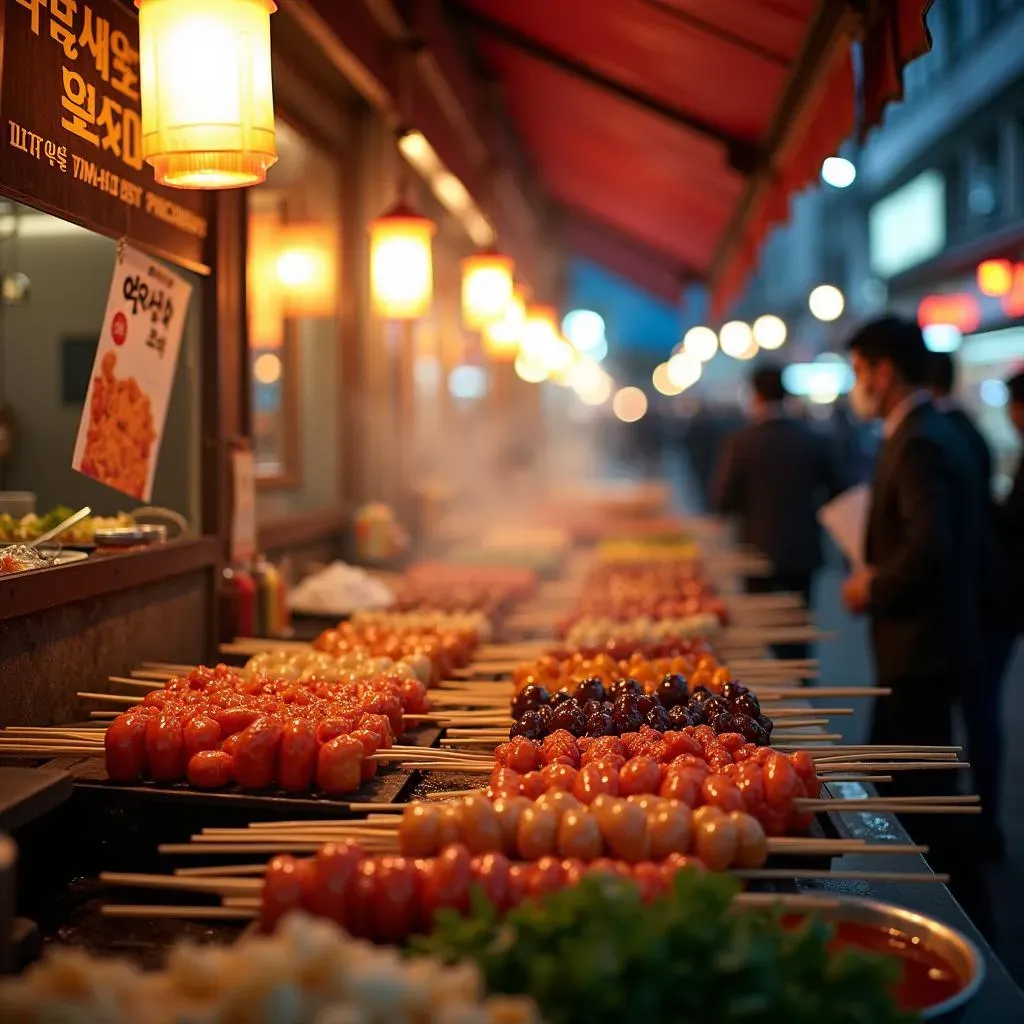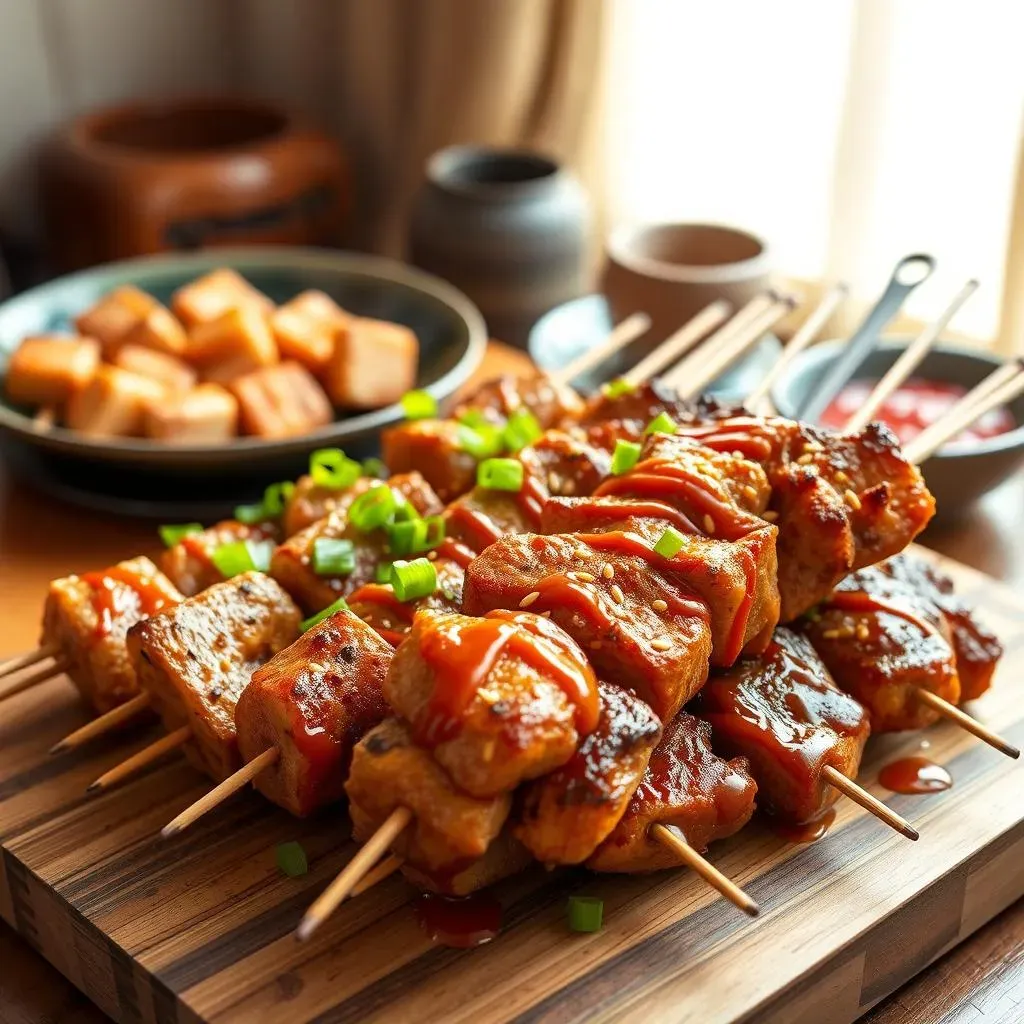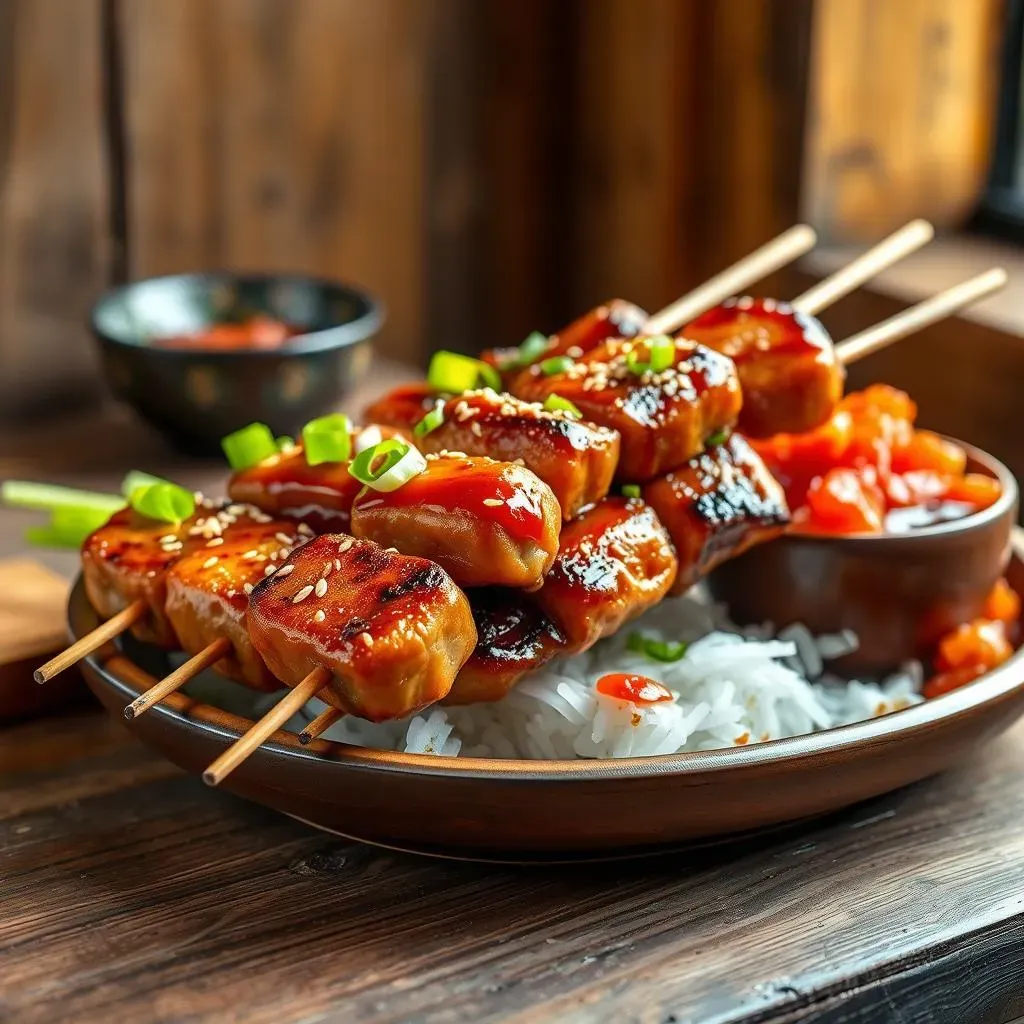Table of Contents
Get ready for a mouthwatering journey through the vibrant world of Korean skewers street food! From the sizzling streets of Seoul to your own kitchen, we're about to explore the incredible diversity and deliciousness of these iconic treats. This article will take you on a culinary adventure, uncovering the secrets behind some of the most popular Korean skewers, like the savory Dakkochi (chicken skewers) and the chewy, spicy Tteokbokki (rice cake skewers). We'll delve into the history and cultural significance of these street food staples, examining their unique ingredients and preparation methods. But it's not just about reading – we'll equip you with the knowledge and recipes to recreate these amazing flavors at home. Whether you're a seasoned foodie or a curious beginner, prepare to be amazed by the simple yet sophisticated world of Korean skewers street food. Let's embark on this delicious exploration together!
Exploring the World of Korean Skewers Street Food
Exploring the World of Korean Skewers Street Food
A World of Flavor on a Stick
Imagine strolling through a bustling Korean market, the air thick with the aroma of sizzling meat and sweet sauces. Everywhere you look, vibrant stalls overflow with colorful skewers, each promising a unique explosion of flavor. This is the magic of Korean street food, and skewers are its shining stars. These aren't your grandma's plain kebabs; Korean skewers are a testament to culinary creativity, blending sweet, savory, spicy, and sometimes even subtly bitter notes into perfectly balanced bites. From the classic Dakkochi (grilled chicken skewers) marinated in a sweet and spicy gochujang sauce to the chewy, savory Tteok-kkochi (rice cake skewers) with their irresistible gooey centers, the variety is staggering. Each region boasts its own unique variations, showcasing the diversity of Korean cuisine and its regional specialties. The experience is as much about the sights and sounds of the bustling market as it is about the tantalizing taste.
Don't be fooled by their seemingly simple presentation. These skewers are often the result of generations of culinary refinement, with secret family recipes passed down through time. The preparation is an art form, involving precise marinades, perfectly timed grilling, and often a final flourish of a special sauce. The quality of ingredients is paramount, ensuring a delicious end product that's both satisfying and memorable. Think of it as a miniature culinary masterpiece, perfectly portioned for on-the-go enjoyment.
Skewer Type | Main Ingredient | Typical Sauce/Flavor Profile |
|---|---|---|
Dakkochi | Chicken | Sweet and Spicy Gochujang |
Tteok-kkochi | Rice Cakes | Sweet and Spicy Gochujang or Soy-based |
Odeng-kkochi | Fish Cakes | Savory, often served in broth |
Beyond the Skewer: Cultural Significance
Korean skewers aren't just about delicious food; they're deeply ingrained in Korean culture. They represent a significant part of the country's street food heritage, a tradition that's been passed down through generations. Street food stalls are often social hubs, places where people gather to enjoy a quick and delicious meal, fostering a sense of community and shared experience. The vibrant energy of these markets is infectious, and the skewers themselves are a symbol of this lively cultural exchange. They're a perfect example of how food can bring people together, transcending age, background, and social status. The act of sharing skewers with friends and family is a common practice, highlighting the importance of togetherness in Korean culture.
Moreover, the sheer variety of skewers reflects the dynamism and adaptability of Korean cuisine. While some skewers maintain traditional recipes, others constantly evolve, incorporating new ingredients and flavors to cater to changing tastes. This innovative spirit is what keeps Korean street food, and its skewers, so exciting and relevant. It's a testament to the country's rich culinary heritage and its willingness to embrace new trends while preserving its traditions. It’s a culinary landscape constantly in motion, always offering something new and delicious to discover.
- Community gathering point
- Reflection of culinary heritage
- Symbol of Korean dynamism and adaptability
Popular Korean Skewers: From Dakkochi to Tteokbokki
Popular Korean Skewers: From Dakkochi to Tteokbokki
Dakkochi: The King of Korean Chicken Skewers
Let's talk about Dakkochi, the undisputed king of Korean chicken skewers. These aren't your average grilled chicken pieces; Dakkochi boasts a unique marinade that's both sweet and spicy, often featuring gochujang (Korean chili paste), soy sauce, garlic, ginger, and a touch of sweetness from honey or sugar. The chicken, usually tender pieces of thigh meat, is expertly marinated for hours, allowing the flavors to penetrate deeply. Then, it's threaded onto skewers with vibrant green onions, adding a fresh, slightly pungent counterpoint to the rich marinade. Grilling the skewers over an open flame or on a hot grill pan brings out the smoky char and intensifies the flavors, creating a truly irresistible treat. The final result is juicy, flavorful chicken with a slightly crispy exterior, perfectly balanced between sweet and spicy. It's a taste sensation that's hard to resist!
One bite of Dakkochi and you'll understand its enduring popularity. The combination of tender chicken, smoky char, and the addictive sweet and spicy sauce is a symphony of flavors. It's no wonder Dakkochi is a ubiquitous sight at Korean street food stalls, festivals, and even casual gatherings. The versatility of Dakkochi also shines through; you can find variations with different marinades and additions like vegetables or even cheese. But the core elements – tender chicken, a balanced sauce, and a delightful char – remain constant, ensuring a consistently delicious experience.
- Tender chicken thigh meat
- Sweet and spicy gochujang-based marinade
- Grilled to perfection for a smoky char
- Often served with green onions
Tteok-kkochi: Chewy Rice Cakes with a Kick
Now, let's move on to Tteok-kkochi, the star of the chewy rice cake show. These skewers feature cylinder-shaped rice cakes (tteok), which are grilled until they develop a delightful crispy exterior while maintaining a soft, chewy interior. The magic lies in the sauce, which is usually a variation of the sweet and spicy gochujang theme, but can also incorporate savory soy sauce-based flavors. The contrast between the chewy rice cakes and the flavorful sauce is incredibly satisfying, offering a textural experience that's both unique and addictive. The addition of other ingredients, like fish cakes or sausages, can also elevate the experience.
Tteok-kkochi is a masterclass in textural contrast. The delightful chewiness of the rice cakes combined with the intense flavors of the sauce creates an unforgettable culinary experience. This is a dish that's both comforting and exciting, a perfect balance of familiar and unexpected. It's also a highly adaptable dish, allowing for creative variations depending on the chef's preference and the availability of ingredients. Whether you prefer a classic sweet and spicy version or something more unique, Tteok-kkochi is sure to leave a lasting impression.
Ingredient | Role |
|---|---|
Rice Cakes (Tteok) | Provide chewy texture |
Gochujang Sauce | Adds sweet and spicy flavor |
Optional additions (fish cakes, sausages) | Enhance flavor and texture |
Making Korean Skewers at Home: Recipes and Tips
Making Korean Skewers at Home: Recipes and Tips
Gathering Your Ingredients: A Culinary Checklist
So, you're ready to bring the magic of Korean skewers into your own kitchen? Fantastic! The first step, and perhaps the most crucial, is gathering your ingredients. Think of it like assembling your culinary army – each ingredient plays a vital role in creating the final delicious masterpiece. For Dakkochi, you'll need boneless, skinless chicken thighs (for ultimate tenderness), green onions (for that fresh bite), and your chosen marinade ingredients (gochujang, soy sauce, garlic, ginger, honey or sugar – adjust to your spice preference!). For Tteok-kkochi, you'll need the cylinder-shaped rice cakes (tteok – readily available at Asian grocery stores), your sauce (gochujang or soy-based), and any optional additions like fish cakes or sausages. Remember, the quality of your ingredients directly impacts the final flavor, so don't skimp on the good stuff!
Don't be intimidated by the ingredient list; most are easily sourced. Asian grocery stores are your best friends here, offering a wide selection of authentic ingredients at reasonable prices. If you can't find specific ingredients, feel free to experiment with substitutes – that's part of the fun! Just remember to maintain the balance of flavors: sweet, spicy, savory. And if you're feeling adventurous, try adding your own unique twist – maybe some kimchi for extra tang, or some sesame seeds for added texture. The possibilities are endless!
Ingredient | Dakkochi | Tteok-kkochi |
|---|---|---|
Protein | Chicken Thighs | Optional: Fish Cakes/Sausages |
Starch | N/A | Rice Cakes (Tteok) |
Sauce Base | Gochujang | Gochujang or Soy Sauce |
Mastering the Technique: Grilling to Perfection
Now for the fun part: grilling! Whether you're using a grill pan indoors or a charcoal grill outdoors, the key is to achieve that perfect balance of smoky char and juicy tenderness. For both Dakkochi and Tteok-kkochi, preheating your grill is essential. A hot grill creates those lovely grill marks and ensures even cooking. Thread your marinated chicken or rice cakes onto skewers, leaving a little space between each piece for even heat distribution. Don't overcrowd the grill; that'll lead to steaming instead of grilling. Grill, turning frequently, until the chicken is cooked through and the rice cakes are nicely browned and slightly crispy. Basting with extra sauce during grilling adds extra flavor and creates that glossy finish. Remember, patience is key – rushed grilling leads to unevenly cooked skewers.
And don't forget the finishing touches! Once your skewers are cooked, let them rest for a minute or two before serving. This allows the juices to redistribute, resulting in a more tender and flavorful bite. Serve immediately, while they're still hot and the sauce is delightfully sticky. Garnish with sesame seeds or chopped green onions for an extra touch of visual appeal and flavor. And there you have it – homemade Korean skewers that are just as delicious, if not more so, than anything you'd find on the streets of Seoul! Experiment with different sauces and additions, and you'll soon be creating your own signature Korean skewer masterpiece.
- Preheat your grill to high heat.
- Don't overcrowd the grill.
- Grill, turning frequently, until cooked through.
- Baste with extra sauce for extra flavor.
- Let rest before serving.